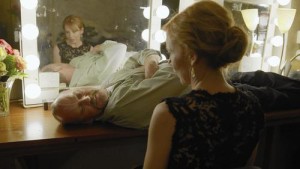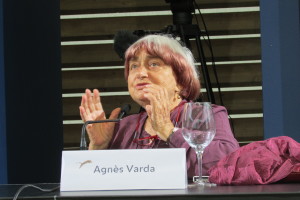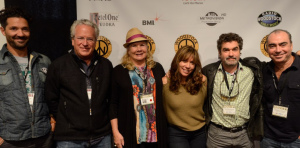 “Remember that we are telling someone else’s story, not our own.” – Allie Light
“Remember that we are telling someone else’s story, not our own.” – Allie Light
In this insightful and enlightening interview (a mini Master Class), Allie Light discusses listening to interviewees, casting a documentary, embracing the unexpected surprises that occur during filming, finding the truth in storytelling, and much more.
Writer, producer, director Allie Light won the Academy Award for Best Documentary Feature for In The Shadow Of The Stars with her partner Irving Saraf. Her credits include: Rachel’s Daughters: Searching for the Causes of Breast Cancer (HBO), Dialogues With Madwomen, (Emmy Award; Freedom of Expression Award, Sundance Film Festival), and Empress Hotel.
Light’s film partner and husband, Irving Saraf, died in 2012.
KOUGUELL: A truly distinct voice and style can set a documentary apart from the competition. How can writers/filmmakers make their voices shine through without imposing their points of view (if this is not their intention), or become a distraction for the viewer?
LIGHT: By listening very carefully to what you are being told by the subject of your film. The film belongs to the person or persons whose stories you are telling. You are helping that person to make the story of her life. All you are is an experienced helper. Of course it’s necessary, if you’ve chosen film as your life’s work, to be a visual and creative person. But draw your ideas from the story you’ve been told. That means you must think ahead and craft an excellent interview. Ask your subject to describe his story, to tell you one more time how she saw what she’s described, how she or he might tell it to a blind person. When you have their stories presented in their own colorful language, you can’t help but work from within their visions.
KOUGUELL: Irving said: “Casting in documentary film is as important as casting in fiction film. You want your subjects to be fascinating, charismatic, surprising and vulnerable—just what you want in fiction characters.” Please elaborate how you ‘cast’ for a documentary.
LIGHT: Casting for a documentary includes much preproduction or pre-planning. With our films, casting has been a slightly different process with each film. Probably In The Shadow of The Stars was our biggest casting chore; the process took many months of preparation. We knew we needed:
1. A group that would include all of the different ‘voices.’ 2. Varying ages. 3. People who were satisfied singing with a group and those who wanted to be soloists. 4. Individuals who had personal stories that might match stories from operas. 5. People who open up, who blossom, when the camera is turned on.
Luckily, all the choristers were actors–a blessing to documentarians who seldom get a chance to work with actors. We began casting by seeking out people who knew choristers: Singing teachers, the chorus director, people who knew someone who sang in the chorus. We met with James Schwabacher, an opera singer and teacher. He gave us a list of names. My first husband had been a chorister so I knew a couple of people from the chorus, whose opinions I could ask. Also, I knew that I wanted to include my husband’s story (though he had died at a young age) so we were looking for singers who had families to support. That’s why we chose Karl and Shelly, who had a child.
Once we had a list of 30 or so singers, we interviewed each, recording the interview on audiotape. We transcribed those tapes, going over each interview, marking it up–for often there were things so beautifully said that we wondered if we could capture the same thing with our cameras. We made our final choices of about 11 people, some would have their full stories told, some would be commentators on opera life and what it takes to devote one’s life to music. Only after we had chosen our singers and were well into production, did we decide to devote time to one kind of voice. Then we had to cast, among sopranos, for the Soprano Tea Party, and among the tenors, for the High Note Competition. By then we knew their voices and their acting skills, so that casting was great fun!
KOUGUELL In your film, Dialogues with Madwomen, you were one of the subjects. What advice do you have for those interested in putting themselves into their film as a subject?
LIGHT: If you are making a film, as I was, about a group of people, including the filmmaker, who were bound together by a common incident (mental illness in the case of Dialogues With Madwomen), then you must feel confident about your role in the film, and confident that you can lead and support all the people who are contributing to the content of your film. As one of the women telling her story, I felt extremely responsible for everyone. I did my interview first, so that the others would know I was as vulnerable as they would be once they sat in front of the camera.
Being on both sides of the camera, I can say with certainty that one is a hotter seat than the other. Once you’ve told your story, you have no idea what the director will do with it, so gaining trust is the most important part of documentary filmmaking. By the time we were finished, the other six women knew that I wouldn’t expect anything from them that I wouldn’t do myself. In putting the stories together, I asked myself many times which choice would be the more truthful. Being in the film helped me to answer some of those questions. In staging reenactments about my own life, I came to realize that having a younger actor play parts of my life was more honest, more real than if I tried to insert my older self into the part of my younger self. I remembered what it was like to experience events when I was 20 or 25, and so I tried to make the story more like reality. I’m not sure I would have so thoughtfully covered that ground with another person–I would have to imagine how she felt at different stages of her life, not really know or remember it.
For someone making a film about themselves, with no other persons taking part, my advice is to be cautious about embellishment. It is too tempting to tell every aspect of your story. Hold back, try to find what is universal in your tale so people can empathize and make comparisons with your story and their own experience. Don’t leave out what’s unique about yourself, but don’t tell your story twice–or three times. Make yourself clear, vulnerable, interesting and exciting, and then trust that your audience will understand you and feel connected. If you are making a film about a subject you care strongly about, use your own voice as narrator (if you think you need one) and say from the beginning why the subject is a passion of yours. In the beginning of Judy Irving’s film, Dark Circle, the sky is filled with a myriad of birds and you hear her tell us how, as a little girl, she walked with her father on the beach and how she loved the birds. It’s a wonderful beginning for a movie about radiation pollution and the sacrifice of living things.
KOUGUELL: In your films, you have utilized dramatic reenactments to convey your story. At what point in the filmmaking process do you decide to use this device? At the script stage? Postproduction?
LIGHT: A good reason for doing reenactments is that the past lives of most people are not documented, so very little material exists to tell the story. Film is a medium of action. If the documentary, or non-fiction filmmaker relies only on the interview, the story is stagnant and becomes merely a retelling of the past. No matter how good the story is, it will bore the viewer and viewers are then a trapped audience with nothing to look at. Our very short reenactments, usually only seconds long, we call emotional equivalents. We treat these images much like Alfred Stieglitz treated his cloud photographs–he called them “equivalents of his own experiences, thoughts, and emotion.” Most of the reenactments in Dialogues With Madwomen are equivalents of what is being spoken at that moment.
I think we have decided to use reenactments in a film at all different stages of its creation. For example when I was interviewing one of the women for Dialogues, she said that she became the Bride of Christ when she made her first Holy Communion. At that instant I knew her statement would be illustrated. The desire to find the perfect image for Christ’s Bride put us on a long trek. Fairly early I knew that I wanted to use a tree for the image. We spent months looking at trees and I decided it should be a bare, winter tree with a veil rising out of it. All along we had been missing the perfect tree–our pear tree, and we evolved to the idea of many veils. I tore up my wedding dress and we hung the lace and net all over the tree. We were able to keep our tripod and camera aimed at the tree so every time the wind blew, we ran out on the deck and filmed the tree. It was perfect and eventually was the opening scene of the movie.
KOUGUELL: What are your thoughts on the documentary Cinema Vérité (“Fly on the Wall”) style?
LIGHT: As Irving Saraf always said, when the small camera replaced the big, bulky, heavy one, cinematographers felt wildly free. It was wonderful to run here and there with a handheld camera and capture stories and events as they happened. This is still true. Cinema Vérité is very special, and there has been a tendency in the last few years for fiction films to be shot this way, so they seem to be happening in the present. Documentary films that use Cinema Vérité seem more charged. The action is happening in front of the viewer, close up, and the film is real and exciting. The one thing Cinema Vérité can’t do is dig deeper into our intellectual and personal lives, to reveal thought, creativity and the imagination. Cinema Vérité is wonderful for the present; it cannot recall the past or the inner workings of our minds.
Sometimes Cinema Vérité and direct cinema are seen as one style, sometimes they are separated and said to be different means of photographing. When they are separated, direct cinema is more the “fly on the wall” and Vérité is seen as an interaction with what is being filmed.
KOUGUELL: Often while shooting, a filmmaker comes upon an unexpected story or twist. What tips do you have on letting these ‘surprises’ enter into the narrative?
LIGHT: How amazing it is to encounter the unexpected moment in a filmmaker’s process of storytelling. The phrase “the privileged moment” has been used to define brief revelations that occur in literature, philosophy and art. Francois Truffaut defined its use in film as “those quick flashes of real life that emerge briefly through the veil of cinematic artifice.” The privileged moment is intensely ‘in and of the present’ and jolts the consciousness in such a way as to remain forever in the present tense.
In my own work I know exactly when those moments have occurred. In a film of ours about the poet Mitsuye Yamada, we brought her to Idaho where she had been interned in a Japanese American Relocation Camp and we were interviewing her on camera. Her description of life in the camps was rather dry and without emotion, when her 17-year old daughter suddenly spoke about how her mother overprotected her as a child. She said to her mother, “You knew what it felt like when someone called you a “Jap”. Mitsuye broke into tears and we had captured a privileged moment.
In another film, about breast cancer, we had followed a young woman dying of the disease. When last we turned our camera on her, as she was lying in bed, she turned her head and said, “Goodbye, Allie. Goodbye, Irving.” This time I broke into tears. I was above Irving’s camera, holding the mic and when we viewed the video, my tears had dripped onto the lens. A privileged moment that we never could have guessed would happen. In spite of my ‘raining’ on the image, we kept that footage in the film.
KOUGUELL: After hearing Werner Herzog speak at the 2013 Locarno Film Festival master class, I was left with some questions, which I pass on to you: What is the truth in the documentary narrative? Is it subjective — satisfying the director’s vision and intent?
LIGHT: Even a news report is subjective, and so most certainly a work of non-fiction will be subjective: Where the camera is placed, how the event is shot, what is used and what is left out, how it is edited. The filmmaker’s creative DNA is on whatever she captures and edits. Editing could be compared, or referred to, as ‘manipulating’. Certainly, arranging identical material in any number of ways will create a different story. Truth in story is definitely related to ethical filmmaking and what choices the filmmaker makes with the material she has.
Remember that we are telling someone else’s story, not our own. Our stories emerge as undercurrents in the work that we do, but often only we are aware of the connection. For example: maybe I wanted to make a film about the artist, Grandma Prisbrey, who made her houses from bottles, each house a unique and brilliant jewel, because I was raised in a housing project where every apartment was drearily the same, and I longed for beauty–such as this story, these are the sub-stories, the inner voices in filmmaking that no one will know, but that ties us irrevocably to our work.
Allie Light concludes our interview: “Upon Irving’s death we were left with an unfinished film Fictitious Shores (about the truth of our lives) that I may someday want to finish. The title is from the line from Emily Dickinson: How many the fictitious shores / before the Harbor be.”
To learn more about Allie Light and Irving Saraf, visit their Web site.
To read more of my interview with Allie Light:
http://www.scriptmag.com/features/susan-kouguell-interviews-academy-award-winning-documentary-filmmaker-allie-light









